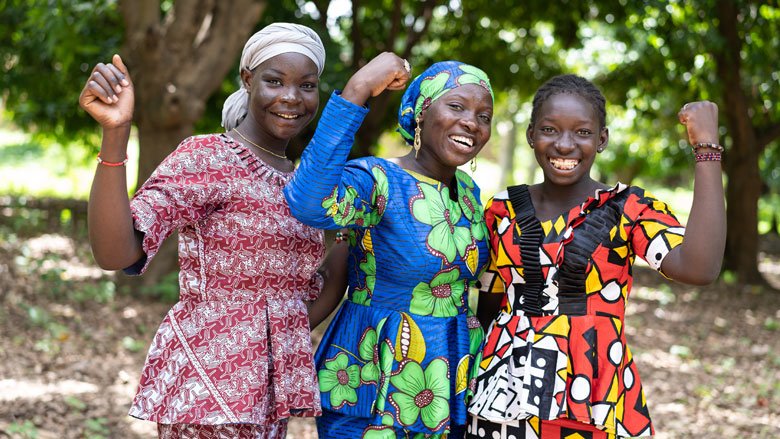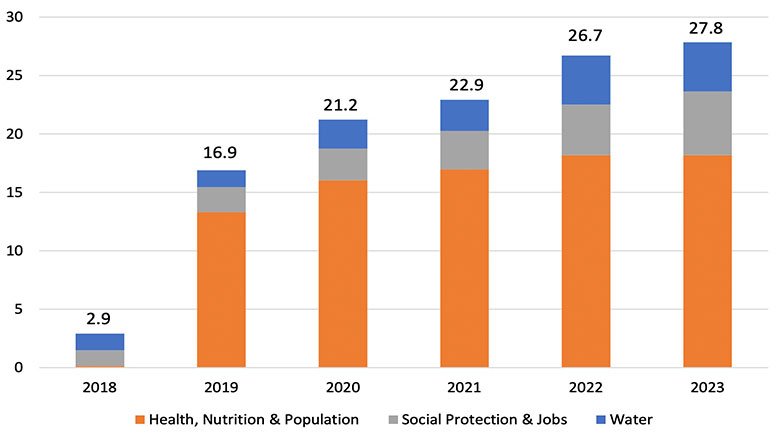CHALLENGES
An Uneven Playing Field
Across multiple dimensions related to human development and socioeconomic empowerment, women and girls in Eastern and Southern Africa lag their male counterparts. For instance, just 43.5 percent of girls in AFE completed lower secondary school according to 2020 data, slightly lower than boys at 45.6 percent. In terms of labor force participation, the gap is even larger, with 65 percent of women employed, compared with 75 percent of men as of 2022. For women who are active in the labor force, their productivity and earnings tend to be lower than those of men in key economic sectors, including agriculture and self-employment. These gaps in outcomes are not due to inherent differences in women and men’s capabilities, but rather stem from women’s lower access to productive resources and to systemic challenges posed by gender norms, policies, and institutions.
Women in the region face high rates of maternal morbidity and mortality, related strongly with differences among countries in skills, resources, and infrastructure. In South Sudan, for example, almost 1,500 out of every 100,000 women die each year in childbirth, compared to 119 in South Africa. The average maternal mortality rate of the region is 391 women per 100,000 live births. According to United Nations Population Fund (UNFPA) estimates, only half of the primary health facilities in the region are fully ready to provide essential primary care. Lack of readiness and functionality of primary health delivery systems contribute to this poor effective coverage and poor quality-of-care of maternal health services.
The burden of HIV/AIDS on maternal health also remains high in many countries in the region. In at least five countries, more than 10 percent of all maternal deaths are estimated to be AIDS-related. Cervical cancer, which is caused by certain strains of the human papillomavirus (HPV), also presents a significant public health threat to women in Africa. All but one of the top 20 countries worldwide with the highest burden of cervical cancer in 2018 were in Africa. In 2020, the top 10 countries with the highest incidence of cervical cancer were in Africa, and nine of those countries were in AFE. Cervical cancer progresses slowly from the precancer stage to invasive cancer, and it is entirely curable if diagnosed and treated early. While this type of cancer is one of the most preventable, poor access to prevention (HPV vaccination), screening, and treatment contributes to 90 percent of deaths. A recent study estimated that more than a million children become orphans each year due to deaths of women from cancer with half of them being breast and cervical cancers.
Women spend far more time than men on unpaid domestic and care work, participate far less in household decision-making, and are overwhelmingly the victims of GBV; in 14 out of the 23 AFE countries, one in four women on average has been subjected to physical or sexual violence in the previous year. Women are also disadvantaged in the ownership of assets: only 37 percent of women in the region have a bank account, compared with 48 percent of men. Similar gaps are seen across other key indicators, from mobile phone ownership to adult literacy.
APPROACH
Strategic Building Blocks for Gender Equality
The World Bank, along with its client countries and partners in AFE—in particular the African Union and the African Development Bank—are working to accelerate gender equality in the region. The World Bank’s Gender Strategy 2016-2023 has informed operations in the region since its adoption. The strategy recognizes the importance of addressing gender equality in access to jobs and the ownership of productive assets. It also emphasizes the importance of addressing gender gaps in health and education, and enlisting men and boys in ending GBV. The Africa Region Gender Action Plan 2018-2022 has provided additional guidance on key themes, frontier issues, and the broad approach of the World Bank’s Africa Region.
Seventeen out of 23 AFE Countries are members of the International Development Association (IDA). Gender has long been a priority for IDA, with the World Bank’s Gender Mainstreaming Strategy informing operations in IDA’s twelfth replenishment (IDA12), gender becoming a Special Theme in IDA16, and successive IDA cycles advancing an increasingly ambitious set of policy commitments.
Ninety-two percent of World Bank projects in AFE were gender tagged in 2022, indicating that they seek to close gender gaps. Projects prioritizing gender in AFE focus on four main thematic areas: (i) improving human endowments through increased access to health, education, and social protection services; (ii) boosting economic opportunities and empowerment, particularly in agriculture and entrepreneurship; (iii) expanding ownership and control of assets; and (iv) reducing GBV. In countries throughout the region, significant achievements have been recorded in each of these areas.
RESULTS
Improving Lives and Livelihoods for East African Women
In East Africa, health, nutrition, education, and social protection are central to enhancing social and economic outcomes for women and girls. Since 2013, 22.4 million women have benefited from improved essential health and nutrition services and water and sanitation supply projects across AFE countries. The region has achieved gender parity in primary education enrollment with 25 million more girls enrolled in primary school in AFE in 2020 than in the early 2000s. Moreover, a total of 5.4 million women benefited from social safety net programs in Ethiopia, Lesotho, Kenya, Madagascar, Rwanda, and Uganda. For example, Ethiopia’s Urban Productive Safety Net Project is on track to reach 604,000 of the poorest and most vulnerable, of whom 71 percent are women. The project combines public works and livelihood grants for some of the poorest urban households, supports direct cash transfers for pregnant mothers, disabled, and the elderly, and provides social services for the destitute. In Rwanda, the World Bank is supporting the government’s ambitious aim to halve the rate of childhood stunting to 19 percent by 2024 with the Stunting Prevention and Reduction Project, through behavior-change interventions in health and nutrition. By the end of 2022, over 350,000 women and 600,000 children under five had benefited from the program. Moreover, large-scale educational programs, like the General Education Quality Improvement Project, have reached an estimated 10.5 million female beneficiaries in Ethiopia.
In terms of economic opportunities, access to finance remains a great obstacle for micro and small enterprises (MSEs) in East Africa, particularly those owned by women. In AFE countries, only 26 percent of women had an account with a financial institution in FY17, and women are 24 percent less likely than men to have an account. Only 10 percent of women borrowed for their business or farm, and business ownership is disproportionately skewed toward men; for instance, 70 percent of Rwanda’s businesses are owned by men. Ethiopia’s Women Entrepreneurship Development Project aims to increase the earnings and employment of MSEs owned or partly owned by participating women entrepreneurs, in part by expanding their access to capital. To date, more than 24,000 women have secured a loan from a participating bank or microfinance institution, increasing their income by 68 percent on average. Over 32,000 women have successfully completed the business and technical training provided. More broadly, owing to the efforts of client countries and their private sector and development partners, women’s financial inclusion in AFE countries went up, with a recorded 27 percent increase in the share of women with an account in a financial institution between 2014 and 2022.
Ownership and control of assets is another outcome mapped in the World Bank’s Gender Strategy, and IDA’s Gender Commitment 6 specifies that at least 70 percent of IDA20 operations involving land activities will include specific actions to strengthen women’s land rights. Good governance is key to tenure for women; projects that improve the performance of local municipalities have benefited 3.3 million women in Ethiopia and Burundi. In Kenya, a program to support the construction of affordable housing units increased the proportion of houses individually owned by women to 46 percent.
In the Democratic Republic of Congo (DRC), a project aimed at preventing and mitigating gender-based violence in North and South Kivu provided prevention activities through the economic empowerment of women in the community and awareness-raising activities. Under this project, the Engaging Men through Accountable Practice Program (EMAP) facilitated group discussions for men with the aim of reducing intimate-partner violence (IPV) and transforming gender norms. The program led to a statistically significant decrease both in the probability and severity of physical IPV among women who experienced high physical and moderate sexual violence before the program. Another project, DRC Girls Learning and Empowerment, is holistically empowering 2.1 million girls in secondary schools by supporting reforms to increase female participation in teaching (currently only 16 percent of teachers in public secondary school are female), putting in place holistic prevention and mitigation measures for sexual abuse and harassment in secondary schools; investing in infrastructure to create safe spaces for girls, reduce commuting distance to school, and improve WASH facilities and menstrual health and hygiene; and introducing sexual and reproductive health modules at school.
A comprehensive safe school program in Tanzania helps create safe learning environments for 1 million students, through counselling, training, and school-level and community interventions. This is buttressed by the implementation of the fee-free secondary education policy, and construction of secondary schools nearer to communities to reduce commute distance.
The World Bank is also tackling harassment and GBV outside of school settings. In the Great Lakes region (DRC, Rwanda, Uganda), a project targeting 1 million female small-scale traders led to a decrease in harassment of these women from 96 percent to 12.3 percent over the 2015-2022 period.
Supporting girls in Zambia Today and Tomorrow Since 2015, IDA has partnered with Zambia to help the country’s most disadvantaged girls and women overcome key challenges. The centerpiece of IDA support—the Girls’ Education and Women’s Empowerment and Livelihoods project, or GEWEL—uses evidence to tackle student dropout, early marriage, GBV and other issues facing women and girls. The project helps adolescent girls transition successfully from primary to secondary school. It also supports transition from subsistence to sustainable livelihoods through skills training, grants, savings support, and mentorship to help women turn piecemeal work into viable microenterprises. To date, the GEWEL program has covered secondary school costs for more than 130,175 girls from poor households. Moreover, 116,891 women from extremely poor households in 76 districts across all 10 provinces of the country have received livelihoods packages consisting of life and business skills training, a productive grant equivalent to $225, mentorship, and support to form savings groups. For Karen Mwamba, GEWEL has been life-changing. “Like most men in the village my husband was a peasant farmer,” she says. “We survived from the little that we grew on our small piece of land, until we started having children. We had no means of feeding or paying their school fees.” With the grant she received from the GEWEL program, Karen bought three goats and used the remainder of the money to buy rice. She began selling rice in her rural community and has been able to successfully improve her family’s quality of life. |


